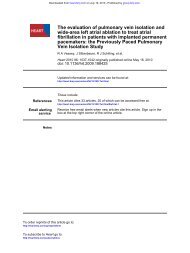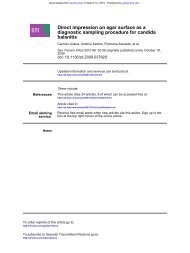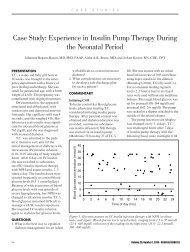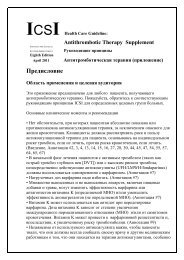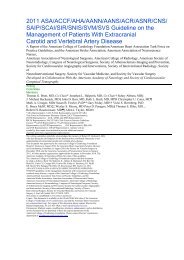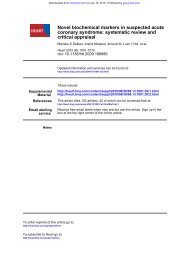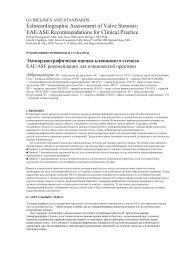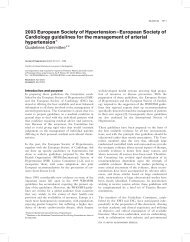echocardiography: basic principles Two dimensional speckle tracking
echocardiography: basic principles Two dimensional speckle tracking
echocardiography: basic principles Two dimensional speckle tracking
You also want an ePaper? Increase the reach of your titles
YUMPU automatically turns print PDFs into web optimized ePapers that Google loves.
References<br />
Email alerting<br />
service<br />
Notes<br />
<strong>Two</strong> <strong>dimensional</strong> <strong>speckle</strong> <strong>tracking</strong><br />
<strong>echocardiography</strong>: <strong>basic</strong> <strong>principles</strong><br />
Hermann Blessberger and Thomas Binder<br />
Heart 2010 96: 716-722<br />
doi: 10.1136/hrt.2007.141002<br />
Updated information and services can be found at:<br />
http://heart.bmj.com/content/96/9/716.full.html<br />
These include:<br />
To order reprints of this article go to:<br />
http://heart.bmj.com/cgi/reprintform<br />
To subscribe to Heart go to:<br />
http://heart.bmj.com/subscriptions<br />
Downloaded from<br />
heart.bmj.com on May 1, 2010 - Published by group.bmj.com<br />
This article cites 36 articles, 12 of which can be accessed free at:<br />
http://heart.bmj.com/content/96/9/716.full.html#ref-list-1<br />
Receive free email alerts when new articles cite this article. Sign up in the<br />
box at the top right corner of the online article.
Education in Heart<br />
1 AKH Linz, Department of<br />
Internal Medicine I - Cardiology,<br />
Krankenhausstrasse, Austria<br />
2 Department of Cardiology,<br />
Medical University of Vienna,<br />
Internal Medicine II, AKH,<br />
Waehringerguertel, Vienna,<br />
Austria<br />
Correspondence to<br />
Professor Dr Thomas Binder,<br />
Department of Cardiology,<br />
Medical University of Vienna,<br />
Internal Medicine II, AKH,<br />
Waehringerguertel 18-20, 1090<br />
Vienna, Austria; thomas.<br />
binder@meduniwien.ac.at<br />
Downloaded from<br />
heart.bmj.com on May 1, 2010 - Published by group.bmj.com<br />
NON-INVASIVE IMAGING<br />
<strong>Two</strong> <strong>dimensional</strong> <strong>speckle</strong> <strong>tracking</strong><br />
<strong>echocardiography</strong>: <strong>basic</strong> <strong>principles</strong><br />
Hermann Blessberger, 1 Thomas Binder 2<br />
<strong>Two</strong> <strong>dimensional</strong> (2D) <strong>speckle</strong> <strong>tracking</strong> <strong>echocardiography</strong><br />
(STE) is a promising new imaging<br />
modality. Similar to tissue Doppler imaging (TDI),<br />
it permits offline calculation of myocardial velocities<br />
and deformation parameters such as strain and<br />
strain rate (SR). It is well accepted that these<br />
parameters provide important insights into systolic<br />
and diastolic function, ischaemia, myocardial<br />
mechanics and many other pathophysiological<br />
processes of the heart. So far, TDI has been the only<br />
echocardiographic methodology from which these<br />
parameters could be derived. However, TDI has<br />
many limitations. It is fairly complex to analyse<br />
and interpret, only modestly robust, and frame rate<br />
and, in particular, angle dependent. Assessment of<br />
deformation parameters by TDI is thus only<br />
feasible if the echo beam can be aligned to the<br />
vector of contraction in the respective myocardial<br />
segment. In contrast, STE uses a completely<br />
different algorithm to calculate deformation: by<br />
computing deformation from standard 2D grey<br />
scale images, it is possible to overcome many of the<br />
limitations of TDI. The clinical relevance of deformation<br />
parameters paired with an easy mode of<br />
assessment has sparked enormous interest within<br />
the echocardiographic community. This is also<br />
reflected by the increasing number of publications<br />
which focus on all aspects of STE and which test<br />
the potential clinical utility of this new modality.<br />
Some have already heralded STE as ‘the next<br />
revolution in <strong>echocardiography</strong>’. This review<br />
describes the <strong>basic</strong> <strong>principles</strong> of myocardial<br />
mechanics and strain/SR imaging which form<br />
a basis for the understanding of STE. It explains<br />
how <strong>speckle</strong> <strong>tracking</strong> works, its advantages to<br />
tissue Doppler imaging, and its limitations.<br />
BACKGROUND<br />
Deformation parametersdstrain and strain rate<br />
Strain is a dimensionless quantity of myocardial<br />
deformation. The so-called Langrangian strain (e) is<br />
mathematically defined as the change of myocardial<br />
fibre length during stress at end-systole<br />
compared to its original length in a relaxed state at<br />
end-diastole¼(l-l0)/l0 (figure 1). 1 Strain is usually<br />
expressed in per cent (%). The change of strain per<br />
unit of time is referred to as strain rate (SR).<br />
Negative strain indicates fibre shortening or<br />
myocardial thinning, whereas a positive value<br />
describes lengthening or thickening.<br />
As SR (1/s) is the spatial derivative of tissue<br />
velocity (mm/s), and strain (%) is the temporal<br />
integral of SR, all of these three parameters are<br />
1 2<br />
mathematically linked to each other (figure 2).<br />
Basically, strain measures the magnitude of<br />
myocardial fibre contraction and relaxation. In<br />
contrast to TDI, it only reflects active contraction<br />
since the STE derived deformation parameters are not<br />
influenced by passive traction of scar tissue<br />
by adjacent vital myocardium (tethering effect) or<br />
cardiac translation. 3 Since contraction is three<br />
<strong>dimensional</strong> and myocardial fibres are oriented differently<br />
throughout the myocardial layers, deformation<br />
can also be described with respect to the different<br />
directional components of myocardial contraction. To<br />
truly understand deformation it is therefore essential<br />
to consider myocardial mechanics.<br />
Basics of myocardial mechanics<br />
The sophisticated myocardial fibre orientation of<br />
the left ventricular (LV) wall provides an equal<br />
distribution of regional stress and strains. 4 In<br />
healthy subjects, the left ventricle undergoes<br />
a twisting motion which leads to a decrease in the<br />
radial and longitudinal length of the LV cavity.<br />
During isovolumetric contraction the apex initially<br />
performs a clockwise rotation. During the ejection<br />
phase the apex then rotates counterclockwise while<br />
the base rotates clockwise when viewed from the<br />
apex. 5 In diastole relaxation of myocardial fibres<br />
and subsequent recoiling (clockwise apical rotation)<br />
contributes to active suction. 5 Thus, the contraction<br />
of the heart is similar to the winding (and<br />
unwinding) of a towel. From a mathematical point<br />
of view several parameters of myocardial mechanics<br />
can be described (figure 3):<br />
< Rotation (degrees)¼angular displacement of<br />
a myocardial segment in short axis view around<br />
the LV longitudinal axis measured in a single<br />
plane.<br />
< Twist or torsion (degrees) which is the net<br />
difference between apical and basal rotation<br />
(calculated from two short axis cross-sectional<br />
planes of the LV). 67<br />
< Torsional gradient (degrees/cm) which is defined<br />
as twist/torsion normalised to ventricular length<br />
from base to apex and accounts for the fact that<br />
a longer ventricle has a larger twist angle. 8<br />
LV twist can be quantified in short axis views by<br />
measuring both apical and basal rotation with the<br />
help of STE (figure 4). In addition, it is possible to<br />
calculate time intervals of contraction/relaxation<br />
with respect to torsion or rotation and therefore<br />
measure the speed of ventricular winding and<br />
unwinding. In particular, the speed of apical recoil<br />
716 Heart 2010;96:716e722. doi:10.1136/hrt.2007.141002
Downloaded from<br />
heart.bmj.com on May 1, 2010 - Published by group.bmj.com<br />
Figure 1 Elastic deformation properties. Strain¼change<br />
of fibre length compared to original length, strain<br />
rate¼difference of tissue velocities at two distinctive<br />
points related to their distance. ΔL, change of length; L o,<br />
unstressed original length; L, length at the end of<br />
contraction; blue arrow, direction of contraction; v1,<br />
velocity point 1; v 2, velocity point 2; d, distance.<br />
during early diastole seems to reflect diastolic<br />
9 10<br />
dysfunction.<br />
Several studies have demonstrated that disturbed<br />
rotational mechanics can be found in many cardiac<br />
disease states and that specific patterns describe<br />
specific pathologies. 9e14<br />
While these parameters are assessed with the<br />
help of STE derived deformation parameters and<br />
describe the ‘mechanics’ of the entire heart, deformation<br />
parameters can also be calculated for individual<br />
segments and specific vectors of direction.<br />
Three different components of contraction have<br />
Figure 2 Mathematical relationship between different deformation parameters and<br />
mode of calculation for <strong>speckle</strong> <strong>tracking</strong> <strong>echocardiography</strong> (STE) and tissue Doppler<br />
imaging (TDI). STE primarily assesses myocardial displacement, whereas TDI primarily<br />
assesses tissue velocity. Modified from Pavlopoulos et al. 1<br />
Education in Heart<br />
been defined: radial, longitudinal, and circumferential<br />
(figure 5).<br />
< Longitudinal contraction represents motion from<br />
the base to the apex.<br />
< Radial contraction in the short axis is perpendicular<br />
to both long axis and epicardium. Thus,<br />
radial strain represents myocardial thickening<br />
and thinning.<br />
< Circumferential strain is defined as the change of<br />
the radius in the short axis, perpendicular to the<br />
radial and long axes.<br />
Longitudinal deformation is assessed from the<br />
apical views while circumferential and radial deformation<br />
are assessed from short axis views of the left<br />
ventricle. The description of these three aforementioned<br />
‘normal strains’dwhich can be measured<br />
using current STE technologydallows a good<br />
approximation of active cardiac motion. However,<br />
they still represent a simplification. When considering<br />
myocardial deformation during contraction in<br />
three <strong>dimensional</strong> space, six more ‘shear strains’ can<br />
be defined in addition to the normal strains. 1 Normal<br />
strains are caused by forces that act perpendicular to<br />
the surface of a virtual cylinder within the myocardial<br />
wall, resulting in en bloc stretching or contraction<br />
without skewing of the volume. Conversely,<br />
forces causing shear strain act parallel to the surface<br />
of such a myocardial block and lead to a shift of<br />
volume borders relative to one another as delineated<br />
by a shear angle a (figure 6).<br />
Reference values for segmental strain were<br />
established for the left ventricle and the left<br />
atrium. 15e19 Normal paediatric strain values are<br />
also available. 18 However, clear cut-offs for peak<br />
systolic strain to define pathologic conditions are<br />
still missing. Marwick et al enrolled 242 healthy<br />
individuals without cardiovascular risk factors or<br />
a history of cardiovascular disease in their multicentre<br />
study and defined normal LV longitudinal<br />
strain values as displayed in table 1. 19 Global<br />
reference values (mean6SEM) for the longitudinal<br />
peak systolic strain (GLPSS: 18.660.1%), peak<br />
systolic SR ( 1.1060.01/s), early diastolic SR<br />
(1.5560.01/s), as well as for the global late diastolic<br />
SR (1.0260.01/s) were also established. 19 Circumferential<br />
and radial LV strain reference values were<br />
determined by Hurlburt et al (table 2). 15 It appears<br />
that longitudinal strain values in the basal<br />
segments are less than in the mid and apical<br />
segments. It remains unclear if this truly reflects<br />
less contractility or if it is a methodological issue.<br />
According to current data, it does not seem necessary<br />
to adjust STE based strain or SR parameters for<br />
sex or indices of LV morphology. Studies investigating<br />
this issue only found a weak relationship or<br />
yielded conflicting results. 15 19e21 However, it has<br />
been shown that with age, LV twisting motion<br />
increases, whereas diastolic untwisting is delayed<br />
and reduced when compared to young individuals.<br />
22 Possibly this is caused by the higher incidence<br />
of diastolic dysfunction with age.<br />
Strain and SR change throughout the cardiac<br />
cycle. To describe systolic myocardial function, it is<br />
best to use peak systolic strain (which reflects<br />
Heart 2010;96:716e722. doi:10.1136/hrt.2007.141002 717
Education in Heart<br />
Downloaded from<br />
heart.bmj.com on May 1, 2010 - Published by group.bmj.com<br />
Figure 3 Rotation of left ventricular apex and base during the heart cycle. Rot, rotation;<br />
l, length; diast, diastole; syst, systole; ap, apical; diff, difference.<br />
Figure 4 Apical and basal rotation during heart cycle. Ordinate, rotation in degrees;<br />
abscissa, time.<br />
Figure 5 Different types of left ventricular myocardial wall strains.<br />
systolic shortening fraction) and peak systolic SR. 23<br />
For timing of contraction the time to peak systolic<br />
strain and SR have been used (beginning of QRS<br />
complex to max peak of strain/SR curve, see figure 7).<br />
By defining the time of aortic valve closure it is<br />
also possible to determine if peak strain in certain<br />
regions occurs before or after the end of systole.<br />
This may be particularly important for the assessment<br />
of dyssynchrony. 24<br />
Such computations can be made for radial,<br />
circumferential, and longitudinal function, either<br />
for individual segments, a cut plane or the entire<br />
ventricle (using averaged values). Thus, strain and<br />
SR provide valuable information on both global and<br />
regional systolic and diastolic function and their<br />
timing.<br />
Basic <strong>principles</strong> of 2D <strong>speckle</strong> <strong>tracking</strong><br />
<strong>echocardiography</strong> (STE): key points<br />
< STE is a novel imaging modality that overcomes<br />
many of the limitations associated with tissue<br />
Doppler imaging.<br />
< STE allows easy assessment of segmental and<br />
global longitudinal, radial, and circumferential<br />
strain and strain rate as well as LV rotation,<br />
torsion, and dyssynchrony.<br />
< Reference values for all LV segments are already<br />
available.<br />
< STE is a valuable tool in evaluating LV systolic<br />
function and provides information on top of<br />
ejection fraction.<br />
< STE also proved useful to investigate LV<br />
diastolic dysfunction.<br />
< Application of STE is limited by image quality,<br />
out-of-plane motion of <strong>speckle</strong>s, lack of clear<br />
cut-off values for clinical decision making, and<br />
software issues (correct definition of ROI, intervendor<br />
comparability of values).<br />
How does 2D <strong>speckle</strong> <strong>tracking</strong> work?<br />
STE was introduced by Reisner, Leitman, Friedman,<br />
and Lysyansky in 2004. 25 26 It is performed as an<br />
offline analysis from digitally recorded and ECG<br />
triggered cine loops. The algorithm uses <strong>speckle</strong><br />
artefacts in the echo image which are generated at<br />
random due to reflections, refraction, and scattering<br />
of echo beams. Such <strong>speckle</strong>s in the LV wall are<br />
tracked throughout the cardiac cycle. Some of these<br />
<strong>speckle</strong>s stay stable during a part of the heart cycle<br />
and can be used as natural acoustic markers for<br />
tagging the myocardial motion during the cardiac<br />
cycle. The post-processing software defines<br />
a ‘cluster of <strong>speckle</strong>s’ (called a ‘kernel’) and follows<br />
this cluster frame to frame (figure 8). 1 Detection of<br />
spatial movement of this ‘fingerprint’ during the<br />
heart cycle now allows direct calculation of<br />
Langrangian strain. Tissue velocity is estimated<br />
from the shift of the individual <strong>speckle</strong>s divided by<br />
the time between successive frames. Strain rate can<br />
be calculated from tissue velocity as well (figure 2).<br />
Before strain analysis can be performed, it is essential<br />
to correctly track the endocardial and epicardial<br />
borders of the left ventricle, and thereby correctly<br />
define the region of interest (ROI) (figure 9).<br />
After definition of ROI in the long or short axis<br />
view, the post-processing software automatically<br />
divides the ventricle into six equally distributed<br />
718 Heart 2010;96:716e722. doi:10.1136/hrt.2007.141002
Figure 6 Shear strain. A, surface area; F, force; Δx, border shift; L, height; a, shear angle.<br />
segments. Several different approaches and<br />
varying degrees of user interaction are required<br />
depending on the scanner type and the echocardiographic<br />
view (parasternal vs apical). Endocardial<br />
<strong>tracking</strong> also allows computation of LV area<br />
changes during the cardiac cycle and can, thus,<br />
also be used to define end-systole and end-diastole.<br />
The raw data are filtered and mathematical algorithms<br />
are applied to generate values. Several<br />
different display formats have been used to represent<br />
the data both using strain and SR curves and<br />
graphical colour encoded displays. STE proved to be<br />
highly robust and reproducible. 27 Intra- as well as<br />
inter-observer variability between skilled echo<br />
examiners were negligible. 27 From a practical point it<br />
is essential to choose a sector width and transducer<br />
position which provides visibility of the apical and<br />
lateral segments, but which still guarantees frame<br />
rates above 30 Hz, ideally around 50 Hz.<br />
Speckle <strong>tracking</strong> versus tissue Doppler imaging<br />
and MRI<br />
STE has several important advantages compared to<br />
other modalities which are able to measure deformation.<br />
In contrast to MRI, STE is much more<br />
available, cost efficient, can be used ‘bedside’, and<br />
has a shorter procedure and post-processing time.<br />
In comparison to TDI, STE is insonation angle<br />
independent and does not require such high frame<br />
rates, is not subjected to the tethering effect, and<br />
allows straightforward measurement of radial and<br />
circumferential strain in addition to longitudinal<br />
strain. 2 The ‘tethering effect’ is a phenomenon<br />
encountered when TDI is used to assess strain. Scar<br />
tissue which is unable to contract is ‘dragged’ by<br />
adjacent viable myocardium during systole. Since<br />
TDI strain is calculated on the basis of tissue<br />
Table 1 Reference values for segmental longitudinal peak systolic strain<br />
LV segment<br />
(apical 4<br />
chamber view)<br />
Mean peak systolic<br />
longitudinal strain<br />
(%)±SD*<br />
Downloaded from<br />
heart.bmj.com on May 1, 2010 - Published by group.bmj.com<br />
Mean peak systolic<br />
longitudinal strain<br />
(%)±SDy<br />
LV segment<br />
(apical 2<br />
chamber view)<br />
velocities, this motion is falsely assigned with<br />
a negative strain value, and thus assumed to be<br />
actively contracting tissue. In STE, this effect does<br />
not occur as strain is directly calculated from the<br />
frame to frame motion of <strong>speckle</strong> patterns and not<br />
from myocardial velocities.<br />
Strain and systolic function<br />
While both strain and LV ejection fraction (LVEF)<br />
measure LV function, there is a fundamental<br />
difference between the two: strain calculates the<br />
contractility of the myocardium, while LVEF is<br />
a surrogate parameter that describes myocardial<br />
pump function. Even if contractility is reduced,<br />
compensatory mechanisms (ie, ventricular dilatation,<br />
geometry changes) can still assure that stroke<br />
volume remains normal (at least at rest). Thus, STE<br />
is especially suited for the assessment of global and<br />
regional systolic function in patients with heart<br />
failure and apparently normal ejection fraction<br />
(HFNEF). 28 Furthermore, regional dysfunction is<br />
not as apparent when using a global parameter<br />
such as LVEF. In addition, exact calculation of LVEF<br />
requires good image quality, operator experience,<br />
and has a large error of measurement. LVEF is also<br />
much more load dependent than strain. 29 Hooke’s<br />
law 30 summarises the relationship between the<br />
forces contributing to tissue deformation:<br />
Passive wall stress ðtÞ<br />
contractile forceðtÞ ¼ elasticity 3 deformationðtÞ According to this law, passive wall stress and<br />
elasticity both interfere with direct translation of<br />
segmental contractile force into deformation<br />
(strain). Passive wall stress is influenced by LV<br />
loading conditions (LV pressure), ventricle geometry,<br />
and segment to segment interaction, whereas<br />
elasticity is defined by tissue properties.<br />
In summary, strain could be an important<br />
parameter for LV function which can display<br />
cardiac dysfunction on a more fundamental level in<br />
an early stage of disease.<br />
STE longitudinal strain and EF correlate well in<br />
healthy individuals; however, in ST elevation<br />
myocardial infarction survivors and heart failure<br />
patients, for example, the correlation is less strong.<br />
Mean peak systolic<br />
longitudinal strain<br />
(%)±SD*<br />
LV segment (apical<br />
3 chamber view)<br />
Education in Heart<br />
Mean peak<br />
systolic longitudinal<br />
strain (%)±SD*<br />
Basal septal 13.764.0 1764 Basal anterior 20.164.0 Basal anteroseptal 18.363.5<br />
Mid septal 18.763.0 1964 Mid anterior 18.863.4 Mid anteroseptal 19.463.2<br />
Apical septal 22.364.8 2366 Apical anterior 19.465.4 Apical anteroseptal 18.865.9<br />
Apical lateral 19.265.4 2167 Apical inferior 22.564.5 Apical posterior 17.766.0<br />
Mid lateral 18.163.5 1966 Mid inferior 20.463.5 Mid posterior 16.865.0<br />
Basal lateral 17.865.0 1966 Basal inferior 17.163.9 Basal posterior 14.667.4<br />
*Mean left ventricular longitudinal peak systolic segmental strain values calculated from 242 healthy subjects aged 51612 years (between 18 and 80 years) by Marwick et al. 19 Scanner: Vivid<br />
7, GE Medical Systems, Horten, Norway. Software: EchoPAC PC, version 6.0.0, GE Healthcare, Chalfont St Giles, UK.<br />
yMean left ventricular longitudinal peak systolic segmental strain values calculated from 60 healthy subjects aged 39615 years by Hurlburt et al. 15 Scanner: Vivid 7, GE Medical Systems,<br />
Milwaukee, Wisconsin, USA. Software: EchoPac Advanced Analysis Technologies, GE Medical Systems.<br />
LV, left ventricular.<br />
Heart 2010;96:716e722. doi:10.1136/hrt.2007.141002 719
Education in Heart<br />
Table 2 Mean left ventricular circumferential and radial peak systolic segmental strain<br />
values calculated from 60 healthy subjects aged 39615 years by Hurlburt et al 15<br />
LV segment (short axis view<br />
at a basal level, just below<br />
mitral valve)<br />
Downloaded from<br />
heart.bmj.com on May 1, 2010 - Published by group.bmj.com<br />
Mean peak systolic<br />
circumferential strain<br />
(%)±SD<br />
Anterior 2466 39616<br />
Lateral 2267 37618<br />
Posterior 2167 37617<br />
Inferior 2266 37617<br />
Septal 2466 37619<br />
Anteroseptal 26611 39615<br />
Mean peak systolic<br />
radial strain<br />
(%)±SD<br />
Scanner: Vivid 7, GE Medical Systems. Software: EchoPac Advanced Analysis Technologies, GE Medical<br />
Systems.<br />
Figure 7 Longitudinal strain curve with peak longitudinal strain occurring in early<br />
diastole. AVC, aortic valve closure; N, peak systolic longitudinal strain.<br />
This suggests that EF and STE strain reflect<br />
different parameters of systolic LV function. Thus,<br />
STE strain provides information on top of LVEF. 31<br />
Figure 8 Displacement of acoustic markers from frame to frame. Green dots represent<br />
the initial position and red the final position of the <strong>speckle</strong>s.<br />
Deformation and diastolic function<br />
Diastolic dysfunction in patients with normal<br />
systolic function results in impaired myocardial<br />
relaxation and reduced filling of the left ventricle<br />
during early diastole. This state is reflected by<br />
a change of the early diastolic LV (un-) twist<br />
pattern. 9 A decrease of early diastolic apical<br />
untwisting rate (rotR) as well as a shortening or<br />
negativity of time from peak apical diastolic<br />
untwist to mitral valve opening (trotR to MVO) can<br />
be observed (figure 10). 10<br />
Thereby, rotR and trotR to MVO both become less<br />
as diastolic dysfunction progresses. RotR correlates<br />
well with established parameters of diastolic<br />
dysfunction like early diastolic tissue velocity of<br />
septal mitral annulus (e’) and ratio of early diastolic<br />
mitral inflow to tissue velocity of septal mitral<br />
annulus (e:e’). 10<br />
LIMITATIONS OF 2D STRAIN<br />
< Image quality: Even though 2D STE is fairly<br />
robust, image quality is still an issue. In young<br />
healthy subjects, approximately 6% of all LV<br />
segments cannot be analysed due to poor image<br />
quality. 15<br />
< Out of plane motion caused by movement of<br />
the heart during the cardiac cycle: It is unclear<br />
how out of plane motion of <strong>speckle</strong>s and frame<br />
You can get CPD/CME credits for Education in<br />
Heart<br />
Education in Heart articles are accredited by both<br />
the UK Royal College of Physicians (London) and the<br />
European Board for Accreditation in Cardiologydyou<br />
need to answer the accompanying multiple<br />
choice questions (MCQs). To access the questions,<br />
click on BMJ Learning: Take this module<br />
on BMJ Learning from the content box at the top<br />
right and bottom left of the online article. For<br />
more information please go to: http://heart.bmj.<br />
com/misc/education.dtl<br />
< RCP credits: Log your activity in your CPD diary<br />
online (http://www.rcplondon.ac.uk/members/<br />
CPDdiary/index.asp)dpass mark is 80%.<br />
< EBAC credits: Print out and retain the BMJ<br />
Learning certificate once you have completed<br />
the MCQsdpass mark is 60%. EBAC/ EACCME<br />
Credits can now be converted to AMA PRA<br />
Category 1 CME Credits and are recognised by<br />
all National Accreditation Authorities in Europe<br />
(http://www.ebac-cme.org/newsite/?<br />
hit¼men02).<br />
Please note: The MCQs are hosted on BMJ<br />
Learningdthe best available learning website for<br />
medical professionals from the BMJ Group. If<br />
prompted, subscribers must sign into Heart with<br />
their journal’s username and password. All users<br />
must also complete a one-time registration on BMJ<br />
Learning and subsequently log in (with a BMJ<br />
Learning username and password) on every visit.<br />
720 Heart 2010;96:716e722. doi:10.1136/hrt.2007.141002
Downloaded from<br />
heart.bmj.com on May 1, 2010 - Published by group.bmj.com<br />
Figure 9 Semi-automated definition of left ventricular<br />
endocardial and epicardial borders (ROI) in an apical four<br />
chamber view.<br />
rate affect the accuracy of STE. This shortcoming<br />
could be overcome by the use of 3D<br />
<strong>speckle</strong> <strong>tracking</strong> technology.<br />
< Unknown software algorithms: To track<br />
<strong>speckle</strong>s and compute strain and SR values,<br />
filtering algorithms are used. The effect of this<br />
filtering on the results represents a ‘black box’<br />
and may vary from vendor to vendor. It is, thus,<br />
unclear how values from different scanners and<br />
software versions compare. Cross platform<br />
comparisons and a clear definition of global<br />
and regional norm values are essential for<br />
a broad application of STE.<br />
< Correct tracing of myocardial region of<br />
interest: One of the major limitations is the<br />
exact detection of borders. Even though <strong>speckle</strong><br />
<strong>tracking</strong> itself seems to enhance the capabilities<br />
of endocardial delineation, it is still necessary to<br />
correct contours manually. In addition, assessment<br />
of strain and SR also requires definition of<br />
the epicardial borders. In most software versions<br />
a uniform thickness of the myocardium is<br />
assumeddan assumption which is not true.<br />
< Size of left ventricle: A further limitation,<br />
encountered in large ventricles, is that it is often<br />
difficult to image the entire myocardium,<br />
especially the apical segments.<br />
Education in Heart<br />
FUTURE PERSPECTIVES<br />
STE is rapidly evolving both on the investigational<br />
and the technological front. It will be necessary to<br />
clearly define normal values and clinical settings<br />
where STE is useful. A primary goal will be the<br />
definition of cut-off values for medical decision<br />
making and to correlate these with hard end points.<br />
This will also require standardisation among<br />
different scanners to assure cross platform reproducibility<br />
and clear guidelines for the integration of<br />
STE into routine <strong>echocardiography</strong>.<br />
Optimisation of the algorithms for strain and SR<br />
assessment will certainly occur. This will include<br />
a more flexible endo- and epicardial border detection<br />
algorithm that accounts for differences in<br />
myocardial thickness and enhanced mathematical<br />
models and filtering techniques.<br />
Figure 10 Speckle <strong>tracking</strong> derived apical rotation rate of a subject with normal diastology (A) and with pseudonormal<br />
filling pattern. White lines indicate mitral valve opening, arrows indicate peak rotation rate during early diastole.<br />
Reproduced with permission from Perry et al. 10<br />
Three <strong>dimensional</strong> STE applications will help to<br />
improve the understanding of myocardial motion.<br />
The current practice of just measuring longitudinal,<br />
radial, and circumferential strain is a simplification<br />
of the complex myocardial fibre contraction<br />
pattern, and neglects ‘shear strains’ and out-ofplane<br />
motion. These problems may be overcome<br />
with three <strong>dimensional</strong> technology. 32e35<br />
Finally, more advanced technologies will allow<br />
LV rotation/torsion and strain/SR measurement of<br />
the endocardial, midwall, and epicardial myocardial<br />
layers and thus deliver a deeper insight into the<br />
physiology of myocardial mechanics, and permit<br />
the study of global and local processes within the<br />
LV wall. 36<br />
CONCLUSION<br />
STE has developed rapidly from a research tool to<br />
a technique which is on the verge of becoming an<br />
important part of routine <strong>echocardiography</strong>. STE<br />
uses the 2D image to calculate deformation<br />
parameters and is in many aspects superior to TDI.<br />
STE is easy to use, robust and provides a multitude<br />
of new insights into the mechanics and deformation<br />
processes of the myocardium. In particular,<br />
STE could provide important information on<br />
regional and global systolic and diastolic function<br />
Heart 2010;96:716e722. doi:10.1136/hrt.2007.141002 721
Education in Heart<br />
Downloaded from<br />
heart.bmj.com on May 1, 2010 - Published by group.bmj.com<br />
which could translate into improved diagnostics of<br />
heart disease.<br />
Competing interests In compliance with EBAC/EACCME guidelines,<br />
all authors participating in Education in Heart have disclosed potential<br />
conflicts of interest that might cause a bias in the article. The<br />
authors have no competing interests.<br />
Provenance and peer review Commissioned; not externally peer<br />
reviewed.<br />
REFERENCES<br />
1. Pavlopoulos H, Nihoyannopoulos P. Strain and strain rate<br />
deformation parameters: from tissue Doppler to 2D <strong>speckle</strong><br />
<strong>tracking</strong>. Int J Cardiovasc Imaging 2008;24:479e91.<br />
< This paper delivers a good insight into the physical <strong>basic</strong>s<br />
of <strong>speckle</strong> <strong>tracking</strong> <strong>echocardiography</strong>.<br />
2. Marwick TH. Measurement of strain and strain rate by<br />
<strong>echocardiography</strong>: ready for prime time? J Am Coll Cardiol<br />
2006;47:1313e27.<br />
3. Behar V, Adam D, Lysyansky P, et al. The combined effect of<br />
nonlinear filtration and window size on the accuracy of tissue<br />
displacement estimation using detected echo signals. Ultrasonics<br />
2004;41:743e53.<br />
4. Vendelin M, Bovendeerd PH, Engelbrecht J, et al. Optimizing<br />
ventricular fibers: uniform strain or stress, but not ATP<br />
consumption, leads to high efficiency. Am J Physiol Heart Circ<br />
Physiol 2002;283:H1072e81.<br />
5. Sengupta PP, Krishnamoorthy VK, Korinek J, et al. Left ventricular<br />
form and function revisited: applied translational science to<br />
cardiovascular ultrasound imaging. J Am Soc Echocardiogr<br />
2007;20:539e51.<br />
6. Takeuchi M, Nishikage T, Nakai H, et al. The assessment of left<br />
ventricular twist in anterior wall myocardial infarction using two<strong>dimensional</strong><br />
<strong>speckle</strong> <strong>tracking</strong> imaging. J Am Soc Echocardiogr<br />
2007;20:36e44.<br />
7. Notomi Y, Lysyansky P, Setser RM, et al. Measurement of<br />
ventricular torsion by two-<strong>dimensional</strong> ultrasound <strong>speckle</strong> <strong>tracking</strong><br />
imaging. J Am Coll Cardiol 2005;45:2034e41.<br />
8. Henson RE, Song SK, Pastorek JS, et al. Left ventricular torsion is<br />
equal in mice and humans. Am J Physiol Heart Circ Physiol<br />
2000;278:H1117e23.<br />
9. Park SJ, Miyazaki C, Bruce CJ, et al. Left ventricular torsion by<br />
two-<strong>dimensional</strong> <strong>speckle</strong> <strong>tracking</strong> <strong>echocardiography</strong> in patients<br />
with diastolic dysfunction and normal ejection fraction. J Am Soc<br />
Echocardiogr 2008;21:1129e37.<br />
10. Perry R, De Pasquale CG, Chew DP, et al. Assessment of early<br />
diastolic left ventricular function by two-<strong>dimensional</strong><br />
echocardiographic <strong>speckle</strong> <strong>tracking</strong>. Eur J Echocardiogr<br />
2008;9:791e5.<br />
< The article demonstrates the role of STE in assessing<br />
diastolic dysfunction.<br />
11. Ng AC, Tran da T, Newman M, et al. Comparison of left<br />
ventricular dyssynchrony by two-<strong>dimensional</strong> <strong>speckle</strong> <strong>tracking</strong><br />
versus tissue Doppler imaging in patients with non-ST-elevation<br />
myocardial infarction and preserved left ventricular systolic<br />
function. Am J Cardiol 2008;102:1146e50.<br />
12. Saito M, Okayama H, Nishimura K, et al. Determinants of left<br />
ventricular untwisting behaviour in patients with dilated<br />
cardiomyopathy: analysis by two-<strong>dimensional</strong> <strong>speckle</strong> <strong>tracking</strong>.<br />
Heart 2009;95:290e6.<br />
13. Wang J, Nagueh SF, Mathuria NS, et al. Left ventricular twist<br />
mechanics in a canine model of reversible congestive heart failure:<br />
a pilot study. J Am Soc Echocardiogr 2009;22:95e8.<br />
14. Sun JP, Stewart WJ, Yang XS, et al. Differentiation of<br />
hypertrophic cardiomyopathy and cardiac amyloidosis from other<br />
causes of ventricular wall thickening by two-<strong>dimensional</strong> strain<br />
imaging <strong>echocardiography</strong>. Am J Cardiol 2009;103:411e15.<br />
15. Hurlburt HM, Aurigemma GP, Hill JC, et al. Direct ultrasound<br />
measurement of longitudinal, circumferential, and radial strain<br />
using 2-<strong>dimensional</strong> strain imaging in normal adults.<br />
Echocardiography 2007;24:723e31.<br />
< Reference values for longitudinal, circumferential, and<br />
radial strain in adults.<br />
16. Teske AJ, Prakken NH, De Boeck BW, et al. Echocardiographic<br />
tissue deformation imaging of right ventricular systolic function in<br />
endurance athletes. Eur Heart J 2009;30:969e77.<br />
17. Cameli M, Caputo M, Mondillo S, et al. Feasibility and reference<br />
values of left atrial longitudinal strain imaging by two-<strong>dimensional</strong><br />
<strong>speckle</strong> <strong>tracking</strong>. Cardiovasc Ultrasound 2009;7:6.<br />
18. Bussadori C, Moreo A, Di Donato M, et al. A new 2D-based<br />
method for myocardial velocity strain and strain rate quantification<br />
in a normal adult and paediatric population: assessment of<br />
reference values. Cardiovasc Ultrasound 2009;7:8.<br />
19. Marwick TH, Leano RL, Brown J, et al. Myocardial strain<br />
measurement with 2-<strong>dimensional</strong> <strong>speckle</strong>-<strong>tracking</strong><br />
<strong>echocardiography</strong>: definition of normal range. JACC Cardiovasc<br />
Imaging 2009;2:80e4.<br />
< Reference values for longitudinal strain and strain rate in<br />
adults.<br />
20. Ng AC, Tran da T, Newman M, et al. Left ventricular longitudinal<br />
and radial synchrony and their determinants in healthy subjects.<br />
J Am Soc Echocardiogr 2008;21:1042e8.<br />
21. Oxborough D, Batterham AM, Shave R, et al. Interpretation of two<strong>dimensional</strong><br />
and tissue Doppler-derived strain (epsilon) and strain<br />
rate data: is there a need to normalize for individual variability in left<br />
ventricular morphology? Eur J Echocardiogr 2009;10:677e82.<br />
22. Takeuchi M, Nakai H, Kokumai M, et al. Age-related changes in<br />
left ventricular twist assessed by two-<strong>dimensional</strong> <strong>speckle</strong>-<strong>tracking</strong><br />
imaging. J Am Soc Echocardiogr 2006;19:1077e84.<br />
23. Sutherland GR, Di Salvo G, Claus P, et al. Strain and strain rate<br />
imaging: a new clinical approach to quantifying regional myocardial<br />
function. J Am Soc Echocardiogr 2004;17:788e802.<br />
24. Suffoletto MS, Dohi K, Cannesson M, et al. Novel <strong>speckle</strong>-<strong>tracking</strong><br />
radial strain from routine black-and-white echocardiographic images<br />
to quantify dyssynchrony and predict response to cardiac<br />
resynchronization therapy. Circulation 2006;113:960e8.<br />
< STE derived radial strain was proven useful to assess<br />
dyssynchrony and predict response to cardiac<br />
resynchronisation therapy.<br />
25. Leitman M, Lysyansky P, Sidenko S, et al. <strong>Two</strong>-<strong>dimensional</strong><br />
strain-a novel software for real-time quantitative<br />
echocardiographic assessment of myocardial function. J Am Soc<br />
Echocardiogr 2004;17:1021e9.<br />
26. Reisner SA, Lysyansky P, Agmon Y, et al. Global longitudinal<br />
strain: a novel index of left ventricular systolic function. J Am Soc<br />
Echocardiogr 2004;17:630e3.<br />
27. Belghitia H, Brette S, Lafitte S, et al. Automated function<br />
imaging: a new operator-independent strain method for assessing<br />
left ventricular function. Arch Cardiovasc Dis 2008;101:163e9.<br />
28. Edvardsen T, Helle-Valle T, Smiseth OA. Systolic dysfunction in<br />
heart failure with normal ejection fraction: <strong>speckle</strong>-<strong>tracking</strong><br />
<strong>echocardiography</strong>. Prog Cardiovasc Dis 2006;49:207e14.<br />
29. Becker M, Kramann R, Dohmen G, et al. Impact of left ventricular<br />
loading conditions on myocardial deformation parameters: analysis<br />
of early and late changes of myocardial deformation parameters<br />
after aortic valve replacement. J Am Soc Echocardiogr<br />
2007;20:681e9.<br />
< This paper elegantly demonstrated that LV pre- and<br />
afterload conditions influence deformation parameters.<br />
30. Bijnens BH, Cikes M, Claus P, et al. Velocity and deformation<br />
imaging for the assessment of myocardial dysfunction. Eur J<br />
Echocardiogr 2009;10:216e26.<br />
31. Delgado V, Mollema SA, Ypenburg C, et al. Relation between<br />
global left ventricular longitudinal strain assessed with novel<br />
automated function imaging and biplane left ventricular ejection<br />
fraction in patients with coronary artery disease. J Am Soc<br />
Echocardiogr 2008;21:1244e50.<br />
< LVEF and global longitudinal strain were shown to be less<br />
correlated in patients with heart failure or ST elevation<br />
myocardial infarction. Thus, global longitudinal strain provided<br />
information different from that of LVEF in these patients.<br />
32. Kawagishi T. Speckle <strong>tracking</strong> for assessment of cardiac motion<br />
and dyssynchrony. Echocardiography 2008;25:1167e71.<br />
33. Kapetanakis S, Kearney MT, Siva A, et al. Real-time three<strong>dimensional</strong><br />
<strong>echocardiography</strong>: a novel technique to quantify global<br />
left ventricular mechanical dyssynchrony. Circulation<br />
2005;112:992e1000.<br />
34. Marsan NA, Bleeker GB, Ypenburg C, et al. Real-time three<strong>dimensional</strong><br />
<strong>echocardiography</strong> permits quantification of left<br />
ventricular mechanical dyssynchrony and predicts acute response<br />
to cardiac resynchronization therapy. J Cardiovasc Electrophysiol<br />
2008;19:392e9.<br />
35. Marsan NA, Henneman MM, Chen J, et al. Real-time three<strong>dimensional</strong><br />
<strong>echocardiography</strong> as a novel approach to quantify left<br />
ventricular dyssynchrony: a comparison study with phase analysis<br />
of gated myocardial perfusion single photon emission computed<br />
tomography. J Am Soc Echocardiogr 2008;21:801e7.<br />
36. Goffinet C, Chenot F, Robert A, et al. Assessment of subendocardial<br />
vs. subepicardial left ventricular rotation and twist using two<strong>dimensional</strong><br />
<strong>speckle</strong> <strong>tracking</strong> <strong>echocardiography</strong>: comparison with<br />
tagged cardiac magnetic resonance. Eur Heart J 2009;30:608e17.<br />
722 Heart 2010;96:716e722. doi:10.1136/hrt.2007.141002


